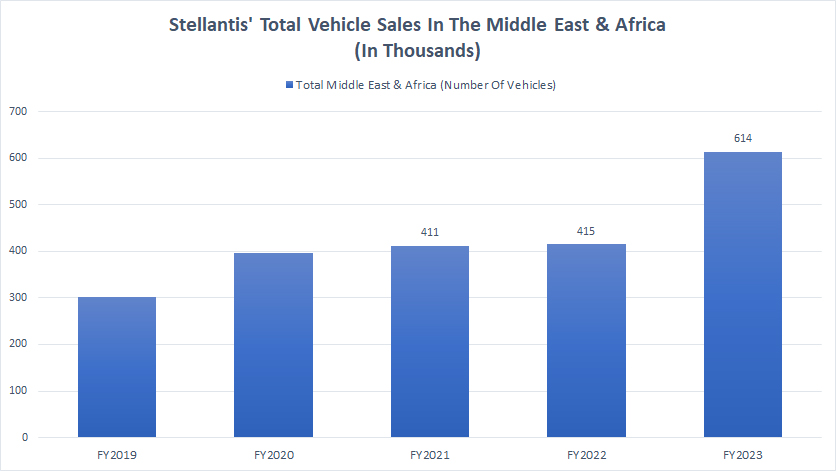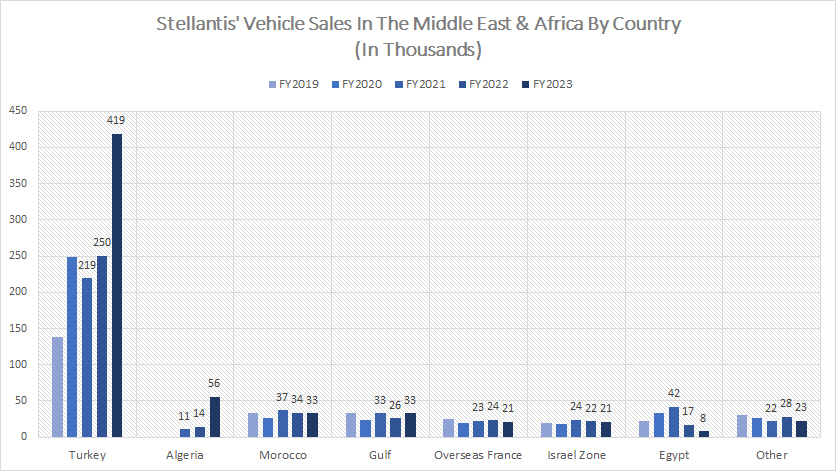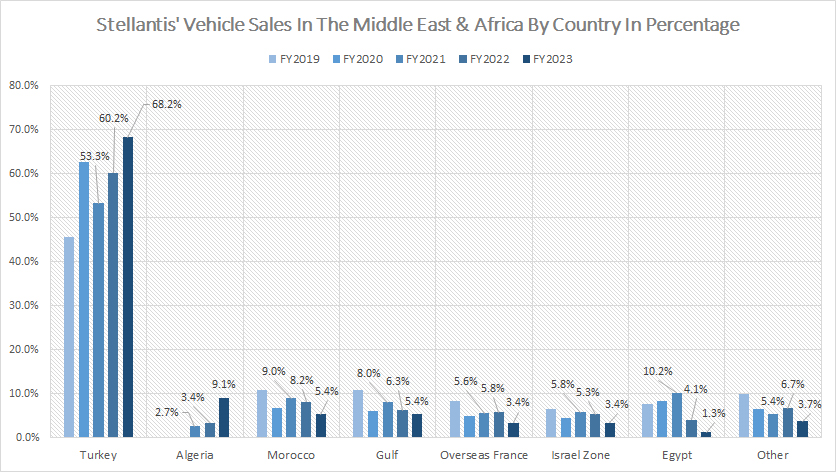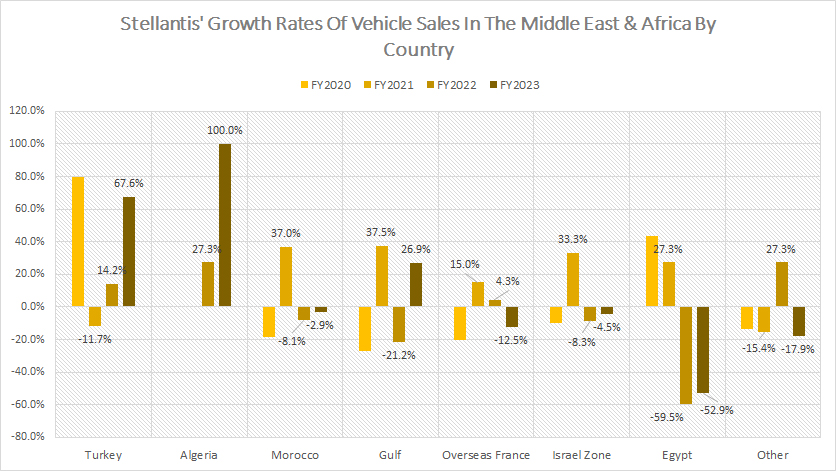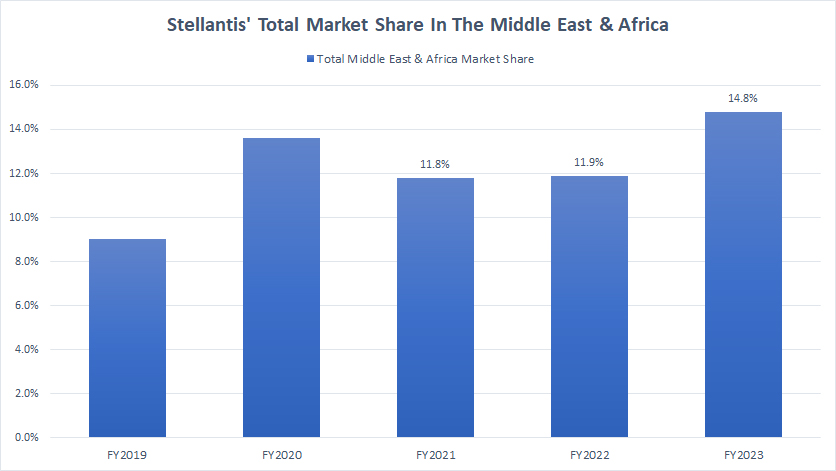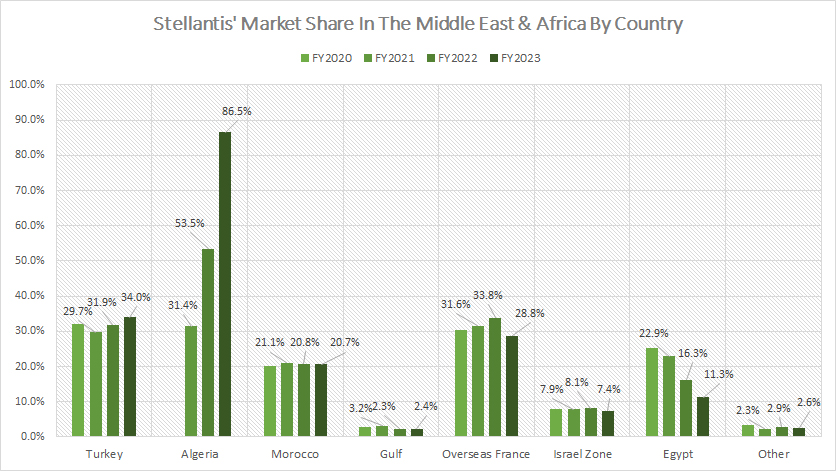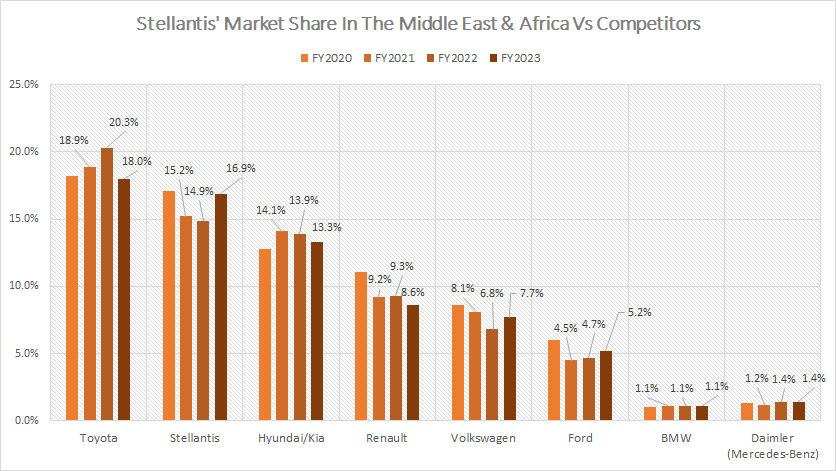
MEA. Pixabay image.
Stellantis is a global automotive group formed in January 2021 after the merger of two major car manufacturers, PSA Group and Fiat Chrysler Automobiles (FCA). With a presence in over 130 countries, Stellantis is one of the largest automotive companies in the world.
In the Middle East and Africa, Stellantis has a strong presence with a wide range of popular brands, including Peugeot, Citroën, DS Automobiles, Fiat, Alfa Romeo, Chrysler, Jeep, and RAM. The company’s regional operations are managed by Stellantis Middle East and Africa (MEA), headquartered in Dubai, United Arab Emirates.
Stellantis MEA is responsible for sales, marketing, and aftersales services for all the Stellantis brands in the region. The company has a network of over 200 dealerships and service centers across the Middle East and Africa, providing customers easy access to high-quality products and services.
This article covers Stellantis’ vehicle sales, market share in the Middle East & Africa, and its competitive position in this region versus its competitors.
Investors interested in Stellantis’ vehicle sales and market share in North America and Europe may find more information on these pages: Stellantis North America and Stellantis Europe.
Let’s get started!
Please use the table of contents to navigate this page.
Table Of Contents
Definitions And Overview
O2. Stellantis Business Strategy In The Middle East & Africa
O3. How Does Stellantis Distribute Its Vehicles In The Middle East & Africa
O4. How Does Stellantis Provide Financing To Customers In The Middle East & Africa
Consolidated Sales
A1. Vehicle Sales In The Middle East & Africa
Sales By Country
B1. Vehicle Sales In Turkey, Algeria, Morocco, Gulf, Israel, Egypt, etc.
B2. Vehicle Sales In Turkey, Algeria, Morocco, Gulf, Israel, Egypt, etc., In Percentage
B3. Growth Rates Of Vehicle Sales In Turkey, Algeria, Morocco, Gulf, Israel, Egypt, etc.
Consolidated Market Share
C1. Market Share In The Middle East & Africa
Market Share By Country
D1. Market Share In Turkey, Algeria, Morocco, Gulf, Israel, Egypt, etc.
Market Share Vs Competitors
E1. Market Share In The Middle East & Africa Vs Competitors
Conclusion And Reference
S1. Conclusion
S2. References and Credits
S3. Disclosure
Definitions
To help readers understand the content better, the following terms and glossaries have been provided.
Gulf: The Gulf includes Bahrain, Kuwait, Oman, Qatar, Saudi Arabia, UAE, and Yemen.
Overseas France: Overseas France includes French Guiana, Mayotte, Reunion, Martinique and Guadeloupe.
Israel Zone: Israel Zone includes Israel and Palestine.
Other: Other excludes Iran, Sudan and Syria.
New Vehicle Sales: Stellentis defines its new vehicle sales as the sales of vehicles primarily by dealers and distributors or, directly by the company in some cases, to retail customers and fleet customers.
Sales include mass-market and luxury vehicles manufactured at Stellantis’ plants and vehicles manufactured by joint ventures and third-party contract manufacturers and distributed under its brands. Sales figures exclude sales of vehicles that it contracts to manufacture for other OEMs.
While vehicle sales are illustrative of Stellantis’s competitive position and the demand for its vehicles, sales are not directly correlated to net revenues, cost of revenues, or other measures of financial performance in any given period.
For a discussion of Stellantis’ vehicle shipments that directly correlate to its Net revenues, Cost Of revenues, and other financial measures, you may visit this article: Stellantis Vehicle Wholesale.
Stellantis Business Strategy In The Middle East & Africa
One of the key aspects of Stellantis’ strategy is establishing a strong manufacturing base in the Middle East & Africa. The company plans to leverage the manufacturing capabilities of its existing facilities in Morocco, Egypt, and South Africa to produce vehicles that cater to the needs of local consumers. The company also plans to explore opportunities to establish new regional manufacturing facilities.
Regarding product offerings, Stellantis plans to introduce new models to the market tailored to the needs of the Middle East and Africa. The company has identified SUVs and pick-up trucks as two segments with significant growth potential in the region and plans to introduce new models in these categories.
Stellantis also plans to invest in technology and innovation to improve the overall customer experience. The company will develop new technologies that enhance vehicle safety, connectivity, and sustainability.
Overall, Stellantis’ strategy for the Middle East and Africa is focused on expanding its regional presence by investing in local manufacturing, increasing its product offerings, and leveraging technology and innovation to improve the customer experience.
How Does Stellantis Distribute Its Vehicles In The Middle East & Africa
Stellantis distributes its vehicles in the Middle East and Africa region through various channels.
In Turkey, a national sales company distributes Peugeot, Citroën, DS, and Opel brands. In contrast, Fiat, Alfa Romeo, and Jeep brands are distributed through a joint venture with Koc Automotive Group.
In Morocco, a national sales company manages the distribution of Fiat, Alfa Romeo, and Jeep, while local importers handle Peugeot, Citroën, DS, and Opel brands.
In South Africa, Stellantis operates through a national sales company that distributes all its brands.
Stellantis has agreements with local general distributors for all other regional markets, with its regional offices in Cairo and Dubai coordinating operations in Egypt and the Middle East.
How Does Stellantis Provide Financing To Customers In The Middle East & Africa
Stellantis provides financing to its customers in the Middle East and Africa through various channels.
In Turkey, for example, the activities related to the FCA (Fiat Chrysler Automobiles) brands are carried out through a Tofas subsidiary, which mainly offers financial services to retail customers.
On the other hand, the activities related to the PSA (Peugeot S.A.) brands are carried out by a subsidiary of BPF, which markets a range of retail financing and insurance products in cooperation with TEB Finansman AS, a subsidiary of BNPP PF, and Garanti Bank, a subsidiary of BBVA.
In other markets, Stellantis operates vendor programs with bank partners to provide dealer and retail customer financing access.
For instance, in South Africa, the Stellantis brand sales are supported by Wesbank, covering both wholesale and retail financing under the FCA Finance South Africa brand.
In Morocco, FCA Bank provides financing for the dealer financing activity limited to the FCA brands, while private label agreements with Wafasalaf support sales to retail customers.
Vehicle Sales In The Middle East & Africa
Stellantis-vehicle-sales-in-the-Middle-East-and-Africa
(click image to expand)
A definition of Stellantis’ vehicle sales is available here: vehicle sales.
Stellantis’ total vehicle sales in the Middle East & Africa reached 614,000 units in fiscal year 2023, an increase of 200,000 vehicles or 48% over 2022.
Stellantis has maintained a consistent retail volume in the Middle East & Africa since 2019, demonstrating its competitive position in the region.
Vehicle Sales In Turkey, Algeria, Morocco, Gulf, Israel, Egypt, etc.
Stellantis-vehicle-sales-in-the-Middle-East-and-Africa-by-country
(click image to expand)
The definitions of Stellantis’ vehicle sales are available here: vehicle sales. Stellantis’s regions are defined here: Gulf, Overseas France, Israel Zone, and Other.
Stellantis’ biggest market in the Middle East & Africa is Turkey, with vehicle sales reaching 419,000 units as of fiscal year 2023 in this country. The automaker’s 2023 sales in Turkey marked one of the largest increases in 2023 in the MEA region, at nearly 70% year-over-year.
Stellantis’s vehicle sales in Algeria rose 300% in fisal year 2023 from the previous year to reach 56,000 units.
Stellentis sold the same number of vehicles in Morocco and the Gulf, at 33,000 each in fiscal year 2023.
Vehicle sales from countries in Overseas France and Israel Zone came in at 21,000 units and 8,000 units, respectively, in fiscal 2023.
Egypt used to be one of Stellantis’ biggest markets. However, sales in this country has steadily declined over the years. The sales number tumbled to only 8,000 units as of 2023, making it one of the company’s smallest markets.
A noticeable trend is that Stellantis’ vehicle sales in most countries in the Middle East & Africa have remained relatively solid since 2019, highlighting Stellantis’ competitive position in this region.
Vehicle Sales In Turkey, Algeria, Morocco, Gulf, Israel, Egypt, etc., In Percentage
Stellantis-vehicle-sales-in-the-Middle-East-and-Africa-by-country-in-percentage
(click image to expand)
Stellantis’s regions are defined here: Gulf, Overseas France, Israel Zone, and Other.
Vehicle sales from Turkey made up about 68% of Stellantis’s total retail volume in the Middle East & Africa in fiscal year 2023, up significantly from 60% in 2022.
On the other hand, sales from Algeria represented 9% while Morocco accounted for 5.4% of Stellantis’s total sales in this region in fiscal year 2023. The result from the Gulf formed 5.4% in the same period.
Countries in Overseas France and Israel Zone contributed roughly the same sales percentage to Stellantis in fiscal year 2023, at 3.4% each.
Egypt made up only 1.3% of Stellantis’s total retail volume in the Middle East & Africa as of 2023, down considerably from 10.2% in 2021.
Growth Rates Of Vehicle Sales In Turkey, Algeria, Morocco, Gulf, Israel, Egypt, etc.
Stellantis-growth-rates-of-vehicle-sales-in-the-Middle-East-and-Africa-by-country
(click image to expand)
Stellantis’s regions are defined here: Gulf, Overseas France, Israel Zone, and Other.
Stellantis’ vehicle sales growth in Turkey topped 67.5% in 2023, one of the highest rates ever measured in this country. The automaker’s growth rate in Turkey has averaged 23% in the last three years.
Stellantis’ sales in Algeria grew 300% (capped at 100% in the chart) in 2023, while its result in Gulf topped 27%.
Countries in the Middle East & Africa that registered a sales decline were Morocco, Overseas France, Israel Zone, and Egypt. Stellantis suffered the worst sales decline in Egypt in 2023, at more than 50% year-over-year.
Market Share In The Middle East & Africa
Stellantis-market-share-in-the-Middle-East-and-Africa
(click image to expand)
Stellantis’ market share in the Middle East & Africa reached 14.8% as of fiscal year 2023, a significant increase from the 11.9% in 2022.
Since 2019, Stellantis’ market share in the Middle East & Africa has slightly increased and remained relatively firm, indicating the company’s strong competitive advantage in this region.
Market Share In Turkey, Morocco, Gulf, Israel, Egypt, etc.
Stellantis-market-share-in-the-Middle-East-and-Africa-by-country
(click image to expand)
The definitions of Gulf, Overseas France, Israel Zone, and Other are available here: Gulf, Overseas France, Israel Zone, and Other.
Stellantis’ market share in Turkey reached 34% as of 2023, one of the highest among all countries in comparison in the Middle East & Africa and was much higher than the 31.9% in 2022.
In fiscal year 2023, Stellantis had a market share of 86.5% in Algeria, a significant increase from the 53.5% in 2022.
On the other hand, Stellantis’ market share totaled 20.7% in Morocco, while the figure came in at 28.8% for countries in Overseas France.
Stellantis had a market share of only 2.4% in the Gulf region, the lowest among all countries under comparison in the Middle East & Africa.
Stellantis’ market share in Israel has been relatively stable, while the figures in Egypt have significantly decreased from 25% in 2020 to 11% as of 2023.
A noticeable trend is that Stellantis’ market share in most countries in the Middle East & Africa has remained solid except for Egypt.
Market Share In The Middle East & Africa Vs Competitors
Stellantis-market-share-in-the-Middle-East-and-Africa-vs-competitors
(click image to expand)
Stellantis became the second-largest automobile company in the Middle East & Africa after the merger in 2021, only behind Toyota.
As of 2023, Stellantis’ market share in the Middle East & Africa topped 16.9%, while Toyota’s figure reached 18%. Stellantis was only slightly behind Toyota in terms of its competitive position in the MEA region.
Coming in third was Hyundai/Kia, whose market share was 13.3% as of 2023, only slightly behind Stellantis.
Renault and Volkswagen had a market share of 8.6% and 7.7%, respectively, in the Middle East and Africa as of 2023. BMW and Daimler were among the automakers with the lowest market share in the Middle East & Africa, at roughly 1% in 2023.
The only U.S. automaker with a substantial market share in the Middle East & Africa was Ford Motor whose figure came in at 5.2% in 2024 and was ranked the sixth largest in this region.
A noticeable trend is the market share of Toyota and Hyundai/Kia in the Middle East & Africa which has steadily risen since 2020, while the results of most European automakers have declined.
For instance, Stellantis’ market share in the Middle East & Africa saw a noticeable decline from 17.1% in 2020 to 14.8% as of 2022. Renault and Volkswagen saw a similar market share decline in this region between 2020 and 2022.
Conclusion
Stellantis’ market share in the Middle East & Africa has remained firm. The company became the 2nd largest automaker by sales volume in this region after the merger.
Stellantis’ market share in the Middle East & Africa has slowly decreased and was at a distance second from Toyota in 2022. However, its market share rose significantly in 2023 to 16.9% in the MEA region.
Toyota’s market share in the Middle East & Africa decreased to 18% in 2023, while Stellantis’ figure grew, leading to a tight race between these two automakers as of 2023.
References and Credits
1. All financial figures presented in this article were obtained and referenced from Stellantis’ quarterly and annual reports, SEC filings, investor presentations, press releases, etc., which are available in Stellantis Investor Relation.
2. Pixabay images.
Disclosure
References and examples such as tables, charts, and diagrams are constantly reviewed to avoid errors, but we cannot warrant the total correctness of all content.
The content in this article is for informational purposes only and is neither a recommendation nor a piece of financial advice to purchase a stock.
If you find the information in this article helpful, please consider sharing it on social media and provide a link to this article from any website so that more articles like this can be created.
Thank you!

